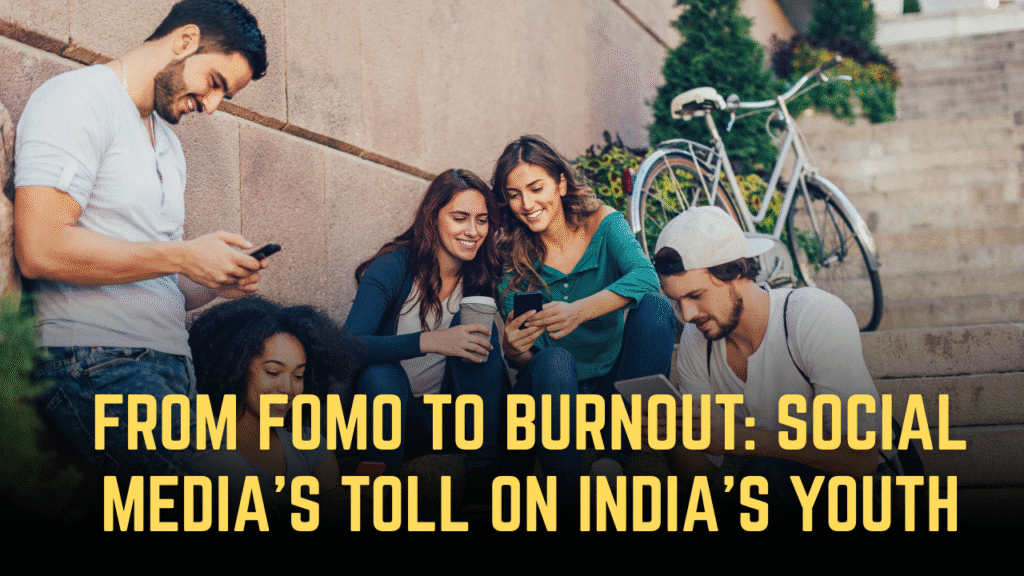
Introduction
In today’s India, social media platforms like Instagram, WhatsApp, and X have become ubiquitous among school and college students. While they offer opportunities for connection and learning, they also fuel deep-seated anxieties—from Fear of Missing Out (FOMO) to emotional exhaustion or burnout. In this blog, we examine the latest data, real-life incidents, and actionable insights to help you understand and address this pressing issue.
1. The Growing Concern: How Widespread Is It?
- 27% of Indian teens show signs of social-media dependency, leading to poor focus, academic underperformance, and mental health challenges.
- A 2022 ICSSR survey found that 65% of teens compare themselves to peers or influencers, triggering feelings of inadequacy.
- The NCRB recorded 13,044 student suicides in 2022, nearly doubling from 2013; they now account for 10% of all suicides.
- Tech partnerships are making a difference—UP police with Meta interventions have prevented over 1,100 self-harm cases since 2023.
2. FOMO: The Silent Agitator
As students endlessly scroll through curated feeds, they often feel left out. Globally, 70% of urban Indian youth report regular FOMO, leading to a doubling of anxiety and depression levels
Psychological research links FOMO to increased stress, fatigue, and sleep disruption, blunting both mental health and academic focus.
3. Mental Health Fallout: Anxiety, Depression & Burnout
Frequent social-media engagement correlates with negative mental states, including anxiety, depression, and low self-esteem.
Notably, 40% of students get less than six hours of sleep nightly due to late-night scrolling.
The compounding effect of FOMO, poor sleep, and constant comparison accelerates a shift into burnout, marked by emotional exhaustion and disengagement.
4. Real Incidents: When Social Media Turns Deadly
- Balasore, Odisha: A 20-year-old college student self-immolated after alleged harassment. Her appeal for help had gone viral, but was ignored until it was too late.
- Sangli, Maharashtra: A 16-year-old girl committed suicide after being blackmailed with videos
- Ashir Nanda, Class IX in Kerala, died by suicide following alleged harassment and ranking-based pressure.
- IIT Kharagpur is launching an AI-powered check-in app and “campus mothers” program to detect distress early, following several student suicides on campus
These cases underscore a chilling pattern: harassment, isolation, and digital pressure leading to irreversible actions.
5. The Hit on Academic Performance & Sleep
Indian Journal of Psychiatry links Instagram use to emotional and academic disruption.
Urban students losing sleep due to screen time face impaired concentration and lowered grades
6. Cyberbullying & Online Harassment
Research from KGMU, Lucknow, highlights a surge in cyberbullying incidents, resulting in severe depression, anxiety, and suicidal thoughts, especially among marginalised students.
Girls remain disproportionately affected, adding another layer of vulnerability.
7. Institutional & Policy Responses
- A Supreme Court task force, led by Justice S. Ravindra Bhat, launched in March 2025 to study student suicides and use social media feedback.
- In Rajasthan, Meta–police collaborations swiftly prevented student suicides, notably in Kota’s coaching centres.
- Odisha Governor and the Union Education Ministry are probing the Balasore incident, indicating rising political action.
8. Recommendations: Toward Healthier Digital Habits
For Parents
- Set clear screen-time limits and enforce offline periods (e.g., after 9 pm).
- Have open, non-judgmental talks about emotional well-being and cyber-safety.
- Model balanced social-media use yourself.
For Educators & Institutions
- Introduce digital literacy—covering privacy, misinformation, bullying & mental health.
- Provide accessible counselling and peer-support systems.
- Adopt early-alert tech (AI apps, “campus mothers”) to spot at-risk students.
For Policymakers
- Enforce age restrictions, content controls, and cyber-safety regulations.
- Integrate mental-health assessments and awareness into education.
- Strengthen the Digital Personal Data Protection Bill for youth privacy and safety online.
Case Study: Implementation in Schools & Colleges
- 1. Maharashtra Peer-Support Workshops
- Pilot programs in Maharashtra showed a 25% reduction in anxiety through structured student support groups.
Recommended format: Weekly sessions on digital well-being and cyberbullying, with faculty oversight. - 2. Noida Secondary Schools (DPS, Amity, Kendriya Vidyalaya)
- Research by Noida International University documented how digital media used in class promoted collaboration and critical thinking.
Takeaway: Blend learning apps and peer projects to harness social platforms for academic benefit. - 3. Kerala “Sathyameva Jayate” Program
- Kannur district introduced a curriculum on misinformation and media literacy (2016–18) using AV tools to teach students how social platforms shape and distort information
Best practice: Integrate media literacy modules into school timetables—focus on verifying sources, detecting filters and clickbait. - 4. Delhi DoE Cyber-Safety Drive
- Delhi government-run schools now run cyber-safety assemblies, advisories, and teacher-led sessions teaching students secure online behaviours (2FA, password hygiene, scam avoidance)
Model to adopt: Monthly digital-safety check-ins during morning assemblies and visible safe-use posters.
Conclusion
From FOMO to burnout, social media poses real risks to Indian youth, eroding sleep, academic success, mental health, and in tragic cases, fuelling suicidal crises. But with coordinated digital literacy, emotional support, early detection, and policy-level interventions, we can curtail this hidden epidemic.
Dr. Ajay Darekar’s call to action: Join Yep
Let’s launch a nationwide movement—cultivating mindful digital use, reinforcing support channels, and building policy safeguards to protect our next generation.
Join the free Community of YEP – Youth Empowerment Program and
visit my website – for more blogs and resources on personal and professional development.
This blog will help everyone wake up to reality and will spread awareness about how the extreme usage of social media affects mental health of teens….. Thank you for such a helpful blog….. 🙏